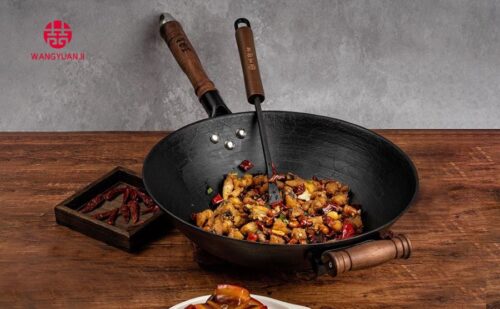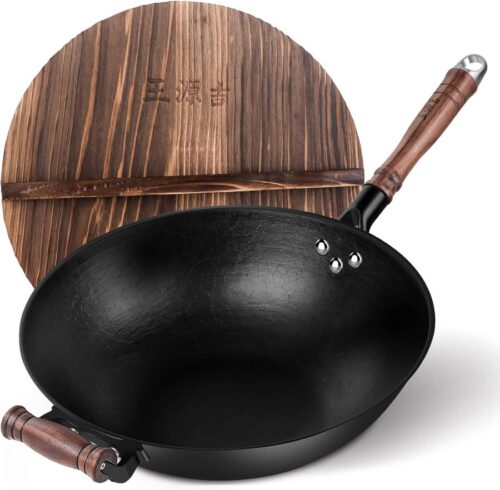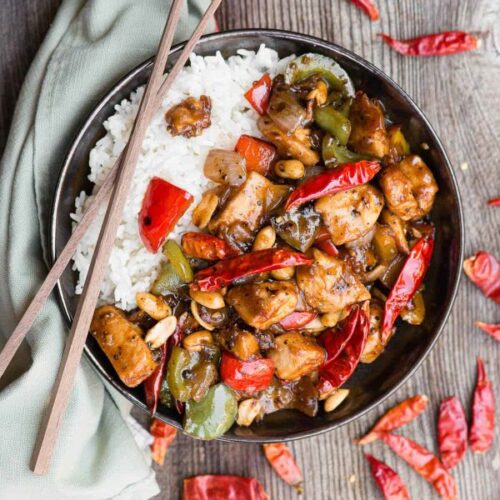The Cast Iron Wok Hei Advantage: The wide base and curved sides of a wok create a unique heating zone. Food cooks quickly at the bottom while remaining tender on top. This rapid cooking process seals in flavors and juices, resulting in the coveted wok hei – a smoky, caramelized essence that defines restaurant-quality Asian dishes.

Choosing the Right Cast Iron Wok
Size Matters: Woks come in various sizes, typically ranging from 12 to 18 inches in diameter. A 14-inch wok is a good all-around choice for home cooks.
Flat vs. Round Bottom: Traditional woks have a round bottom, ideal for high-heat stir-frying on a gas burner with a wok ring. Flat-bottomed woks offer more stability on electric or ceramic cooktops but may not achieve the same level of heat concentration.
Seasoned vs. Unseasoned: Pre-seasoned woks are ready to use straight out of the box. Unseasoned woks require seasoning before use, which involves creating a non-stick layer with oil.
Handles: Woks usually come with two handles or a single helper handle. Double handles offer better control for tossing ingredients during stir-frying.
Additional Considerations: Lids are not essential but can be handy for steaming or simmering. Look for woks with a smooth cooking surface; avoid rough textures that can trap food.

WANGYUANJI Cast Iron Wok
14.2″ Large Wok Stir Fry Pan Flat Bottom Wok with Lid and Wood Handle,Suitable for All Cooktops, Uncoated Craft Wok Healthy Cooking Wok-Practical Gift
Mastering Your Cast Iron Wok: Seasoning and Care
The Seasoning Ritual: Seasoning your cast iron wok creates a protective layer that prevents rust and promotes non-stick cooking. Here’s a basic guide:
- Wash the wok with warm soapy water and dry thoroughly.
- Apply a thin layer of high smoke point oil (vegetable, canola, or peanut) to the entire wok surface.
- Heat the wok over medium-high heat until the oil shimmers.
- Let the wok cool completely. Repeat steps 2-4 two to three times for a stronger seasoning.
Cleaning and Maintenance: After cooking, allow the wok to cool slightly before washing with warm water and a soft sponge. Avoid using harsh soaps or scouring pads. Dry the wok thoroughly with a clean cloth to prevent rust. Apply a thin layer of oil after cleaning for long-term storage.
Never put your cast iron wok in the dishwasher.
Unleashing Your Inner Wok Star: Cooking Techniques and Recipes
The Stir-Fry Symphony: Master the art of stir-frying with your cast iron wok. Here’s the key:
- Heat the wok over high heat with a generous amount of oil.
- Once hot, add your ingredients in stages, starting with aromatics and followed by meats, seafood, and finally vegetables.
- Use a high heat spatula or ladle to constantly toss and stir-fry the ingredients until cooked through.
- Finish with sauces and seasonings for a flavor explosion.
Beyond Stir-Frying: Explore the versatility of your cast iron wok:
- Deep-frying: Heat oil to the desired temperature and carefully fry your chosen ingredients in batches.
- Steaming: Fill the bottom of the wok with a small amount of water and place a steamer basket on top. Add your vegetables or dumplings and steam until cooked.
- Braising: Sear meat in the wok, then add broth, vegetables, and aromatics. Bring to a simmer, cover, and let cook until tender.

Recipe Inspiration:
- Classic Pad Thai: Whip up this iconic Thai stir-fry with rice noodles, scrambled eggs, tofu, vegetables, and a tangy peanut sauce.
- Mongolian Beef: Thinly sliced flank steak, stir-fried with scallions, ginger, and a savory sauce, is a crowd-pleasing dish.
- Szechuan Chicken: For a spicy kick, try this Sichuan chicken recipe featuring tender chicken, chili peppers, and a numbing Sichuan peppercorn sauce.
- Kung Pao Chicken: Another stir-fry classic, Kung Pao chicken combines peanuts, vegetables, chili peppers, and a sweet and savory sauce with tender chicken.
- Vegetable Lo Mein: A vegetarian delight, lo mein features stir-fried noodles with a medley of colorful vegetables.
- Crispy Sesame Shrimp: These lightly battered shrimp are pan-fried in the wok for a delightful combination of crispy texture and juicy flavor.
- Dumplings: Steamed or pan-fried dumplings are a delicious way to showcase your wok’s versatility.
- Korean Bulgogi: Marinated beef strips are stir-fried with vegetables and a savory Korean bulgogi sauce in the wok.
Safety Tips:
- Cast iron woks get very hot. Use oven mitts when handling the wok and lid.
- Be cautious when adding oil to a hot wok, as it can splatter.
- Keep children and pets away from the hot wok while cooking.
The Final Wok Down
The cast iron wok is an investment that will reward you with years of delicious and healthy meals. Its superior heat retention, versatility, and durability make it a worthy addition to any kitchen. With proper seasoning and care, your cast iron wok will become your go-to pan for creating restaurant-quality Asian dishes and so much more. So, unleash your inner wok star and embark on a culinary adventure!

One Response